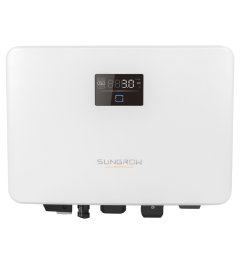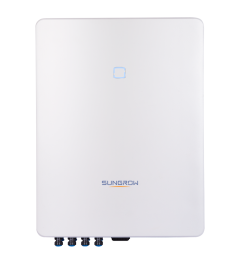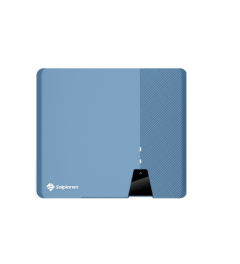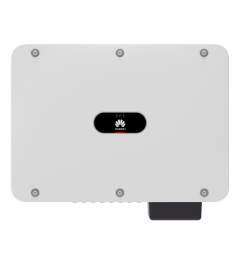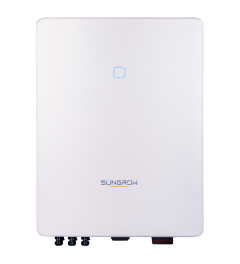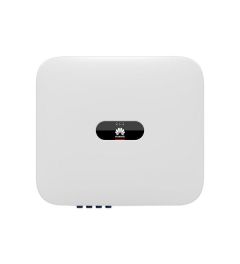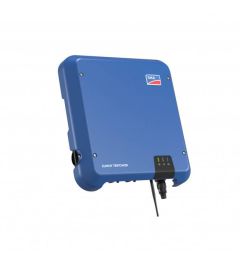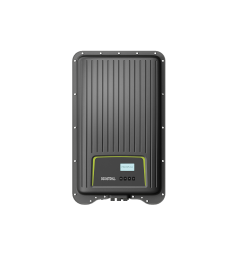Inverters
A PV system is not complete without a good inverter, because only then is the generated solar energy turned into electricity. You can choose from PV system string inverters, micro inverters or hybrid inverters. Optimizers are a good choice for solar panels located partly in the shade.
Our brands
As a solar distributor we supply inverters from top brands including SolarEdge, SMA, Growatt, Kostal Solar and Enphase. We are happy to offer you a varied range so that you can offer the right solution to your customer for every project. If you would like to know more about the differences between the types of inverters, check out our blog: What are the different types of inverters?
An inverter for solar panels is one of the most important elements of the solar energy system. It converts the variable direct current (DC) output of a photovoltaic (PV) solar panel into usable alternating current of 240 V (AC), suitable for use with electrical equipment.
The electricity generated that is not used is then either returned to the grid (power lines) or stored in a local storage system. There are hybrid inverters with integrated battery system available for this.
What different types of inverter are there?
There are different types of inverter for PV systems available on the market. The choice of the right inverter depends on the end use. An inverter converts the direct current (DC) from the solar panels into alternating current (AC). Alternating current (AC) is the electricity that you can use in your home and possibly sell to your energy supplier, whereby the surplus of electricity is passed on to the electricity grid.
Various types of inverters are available in the solar panel market. These are:
- Central inverters, also known as string inverters
- Microinverters
- Power optimizers
- Hybrid inverters
Microinverters and Power Optimizers are collectively often referred to as the group of MLPEs (Module Level Power Electronics). String inverters are, by far, the most widely used type of inverter worldwide. Due to the rapid technological developments, MLPE technology is rapidly gaining popularity and market share, as development costs have fallen significantly in recent years.
In addition to the functionality for converting DC into AC, hybrid inverters also have a battery in which the generated electricity can be stored.
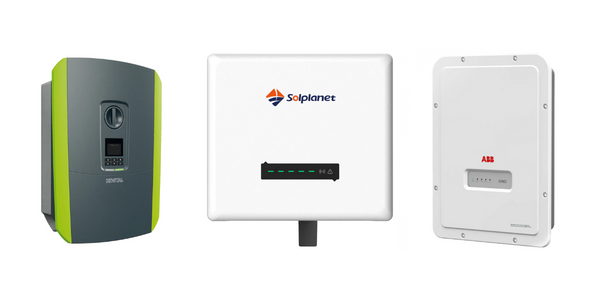
What does an inverter do?
Together with the solar panels, an inverter forms the basis of the system for generating solar energy. The inverter ensures that the energy is safely absorbed into the grid and, equally important, it optimizes the generation under different conditions, so that the maximum amount of energy is generated.
What is MPPT?
MPPT is the mechanism in the inverter that extracts the maximum power from the solar panel. The inverter does by loading the solar panel optimally, rather than maximally.
Due to the constantly changing light conditions (light intensity), shadow and angle of view, the power that a solar panel produces is constant5ly changing. A Maximum Power Point Tracker (MPPT) is a mechanism that searches the solar panel for the point of maximum power delivery and extracts the optimum power from the solar panel under different conditions.
Some inverters have multiple MPPT inputs. The advantage of having multiple MPPTs on a converter is that the output from each MPPT can be split independently. With multiple MPPTs, an inverter can receive input from a series of panels facing in different directions, at different distances, with different output capacities, even with panels of different types.
What is a microinverter?
A microinverter, is a small inverter that you place directly behind the panels. This allows the end user to monitor how the panels perform separately from each other and, if there is a malfunction, it can easily be traced. Microinverters are widely used, particularly in the consumer market. Microinverters are generally more expensive, compared to string inverters and Power Optimizers.
The power generated by the panels is directly converted into alternating current by the microinverters. The power does not enter a 'central' inverter, as it does with many other configurations. In some cases, microinverters are integrated into the solar panel, but they are usually retrofitted to the solar panel mounting system.
One of the top benefits of microinverters is that they reduce the negative effects of shading. The conversion from DC to AC current takes place at each individual panel, so there is no loss of power.
With string inverters, if a single panel fails completely due to a fault or defect, this will lead to the failure of the entire string in a PV arrangement. When using microinverters, the rest of the solar panels will still generate energy, without being hindered by the faulty panel.
How does a string inverter work?
Solar panels are connected in series. For example, when you place 12 solar panels, you do that in 2 series of 6 panels. These 'series' are also called 'strings'. Each string of solar panels is connected to a string inverter that converts the direct current produced by the solar panels into alternating current.
The string inverter is a proven technology that has been used for decades, but is not suitable for every configuration. Every solar configuration is only as efficient as its weakest link. This means that each string of solar panels generates as much power as the least productive solar panel.
When part of the string panels is in the shade during part of the day, this means that the string as a whole generates less power. That is why a string inverter is not always the best choice.
How does a power optimizer work?
Just like a micro-inverter, a power optimizer is connected to each solar panel to optimize the energy yield. Instead of converting the DC power into AC power, the Power Optimizer optimizes the DC power produced, which is then converted by a 'central' inverter.
In addition, the power optimizer constantly provides information about a solar panel, so that any mismatch between the panels in the string becomes clear more quickly. The optimizer can be installed quickly and easily with a single mounting.
Which is the right inverter for me?
When choosing an inverter for your PV project, there are several factors which determine the most suitable type. The questions and answers below can help you in choosing the right inverter.
Which power converter?
The inverter must suit the total capacity of the solar panels. The capacity of solar panels is indicated by the unit WP (Watt peak). This value tells you how much power your solar panels generate in the optimal situation. Of course, reality it is not as perfect as that, so you need to make a conversion. In the Netherlands, 1 Wp produces about 0.85 kWh every year. An average household consumes 3500 kWh per year, and needs about 4000 Wp.
Shade or no shade?
The question of whether the panels are in the shade (partly) or during part of the day is very relevant for the choice of inverter. The power generated by the solar panels is based on the weakest link in a series, in this case, the panel that is most in the shade. This can be overcome in two ways:
Opt for power optimizers or microinverters. These are placed behind each solar panel and the yield of each solar panel is individually optimized.
By making a separate string of the solar panels that are in the shade at the same time. It is important to choose an inverter with several trackers, which continuously check the power of a string.
Which brand of inverter should I choose?
A few years ago, Chinese inverters were not the best choice. Today, the largest Asian brands can compete on par with Western brands. The arrival of the RoHS (2006) quality mark has ensured a quality standard and guarantees the safety of the inverters for solar panels.
The inverters in our range are all from top brands, such as SolarEdge, SMA, Growatt, Kostal and Enphase.
Monitoring
The functioning of the solar panels is always monitored via the inverter. This can be read in different ways. Some inverters have various connections, such as an Ethernet connection, WiFi and Bluetooth. Not all inverters offer standard solutions for this, but the most common ways are:
Via WiFi: many inverters have a WiFi connection, some with both 2.4 and 5Ghz. However, a WiFi connection requires power. All important information can be seen at a glance, with the option of diving deeper into certain data, such as yield, consumption and possible storage. The inverter can be configured and read out via smartphone, tablet or laptop.
Via Bluetooth: Data from the inverter can also be read via Bluetooth. However, this is not the best option, as the connection is often not very strong and not continuous. Moreover, you cannot read the inverter from the internet.
Via Ethernet: with an Ethernet connection, you can connect the inverter to the router with a network cable. A connection is then made to the manufacturer's servers. You can then view the performance of the solar panels from anywhere via an App or website. This connection method is the most stable and recommended, but with some inverters this connection is optional and sometimes a separate module has to be purchased.
Via USB: Some inverters have a USB connection. In this way, the data can only be read at the inverter itself and that is not ideal.
Via built-in web server (latest generation of inverters): You connect the inverter from your own wireless network, which you can then read out.
Zigbee: Zigbee creates a network within your wireless network with which you can not only read and configure your inverter, but you can also control your other home automation.

FOX ESS
FoxESS 1PH Hybrid Inverter H1-3.7-E (with WiFi&EPS)
1 phase, 3.7kW, 2 MPPT, IP65, Hybrid, Current Transformer, WiFi
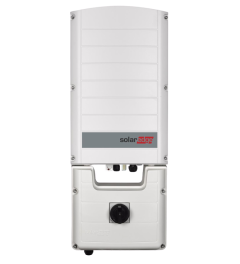
SolarEdge
SolarEdge 3PH Inverter, 25kW, Glands, DC safety unit with switch, AC & DC SPD, Fuses, RSD
3 phase, 25kW, 3 MPPT, IP65

FOX ESS
FoxESS 3PH Hybrid Inverter H3-5.0-E (with WiFi&EPS)
3 phase, 5kW, 2 MPPT, IP65, Hybrid, smart meter, WiFi














